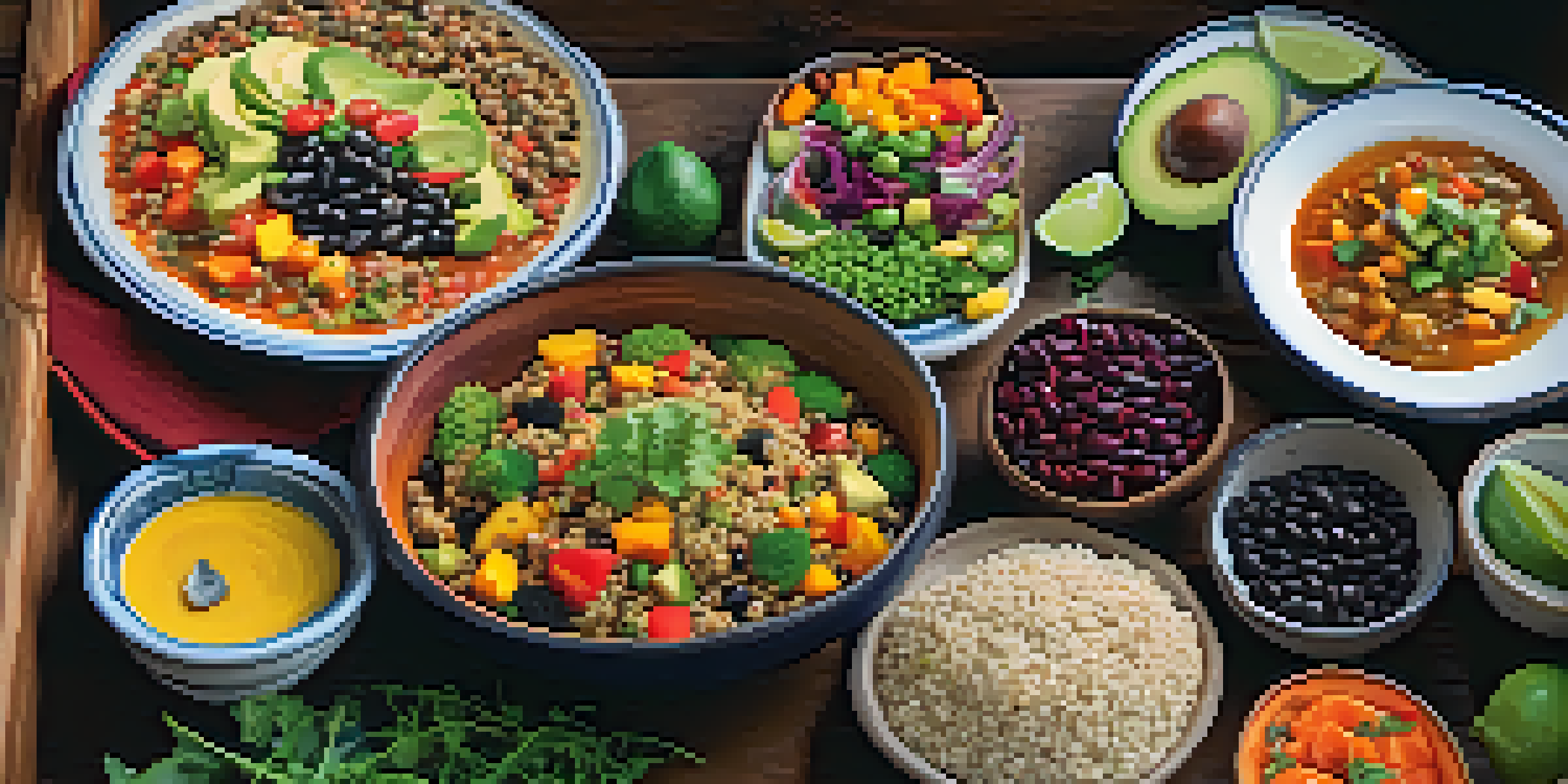Family Meal Planning: Integrating Vegetarian Options Easily

Understanding the Benefits of Vegetarian Meals for Families
Integrating vegetarian meals into your family's diet can offer numerous health benefits, such as reduced cholesterol and improved heart health. These meals are often rich in vitamins, minerals, and fiber, which can contribute to overall well-being. Plus, a plant-based diet can be more sustainable, reducing your family's carbon footprint.
Eating vegetarian is not just a diet; it's an adventure in taste and nutrition.
By embracing vegetarian options, you also encourage your family to explore a variety of foods, which can lead to a more diverse palate. This not only makes meal times more exciting but also helps children develop a love for healthy foods. Consider this an opportunity to introduce new ingredients and flavors that may become family favorites.
Additionally, planning vegetarian meals can be budget-friendly. Often, plant-based proteins like beans and lentils are less expensive than meat. This can ease the strain on your grocery budget while allowing you to experiment with creative recipes.
Setting Realistic Goals for Meal Planning
When it comes to integrating vegetarian options, it's essential to set achievable goals. Rather than going fully meat-free overnight, start by designating one or two days a week as 'Meatless Mondays' or 'Vegetarian Wednesdays.' This gradual approach can make the transition smoother for everyone in the family.

Involve your family in the planning process by discussing what types of vegetarian meals they would enjoy. This inclusion not only increases the likelihood of acceptance but also gives everyone a sense of ownership in the meal planning process. You might be surprised by the enthusiasm for trying new dishes.
Health Benefits of Vegetarian Meals
Integrating vegetarian meals can improve heart health and provide essential nutrients for overall well-being.
Remember that meal planning doesn't have to be perfect. It's okay to have a mix of vegetarian and non-vegetarian meals throughout the week. Flexibility allows you to adapt based on what ingredients you have or what your family is in the mood for.
Stocking Your Pantry with Vegetarian Staples
To make meal planning easier, it's helpful to have a well-stocked pantry filled with vegetarian staples. Items such as canned beans, lentils, whole grains, and a variety of spices can serve as the foundation for countless meals. These ingredients are not only nutritious but also versatile, fitting into various cuisines.
The family that eats together, stays together, and a plant-based diet can bring everyone to the table in new and exciting ways.
Don't forget to include frozen vegetables and fruits in your pantry staples. They can be just as nutritious as fresh produce and are often more convenient. With frozen options on hand, you can quickly whip up a stir-fry, soup, or smoothie any day of the week.
Incorporating a variety of nuts and seeds can also add texture and flavor to your meals. They can be tossed into salads, blended into smoothies, or used as toppings for dishes. This not only enhances the meal but also boosts nutritional content.
Exploring Easy Vegetarian Recipes for Families
As you begin to incorporate more vegetarian meals, exploring simple recipes can be incredibly helpful. Dishes like veggie stir-fries, pasta primavera, or hearty vegetable soups are straightforward and can be made in under 30 minutes. These quick recipes can fit seamlessly into your busy family schedule.
Another great idea is to involve your kids in the cooking process. Children often enjoy helping out in the kitchen, and this can be a fun way to teach them about healthy eating. Simple tasks like washing vegetables or stirring ingredients can make them feel included and invested in the meal.
Family Involvement in Meal Planning
Engaging your family in meal planning fosters enthusiasm and helps everyone feel invested in trying new vegetarian dishes.
Don't hesitate to adjust recipes based on your family's preferences. If a recipe calls for a specific vegetable that no one likes, feel free to swap it out for a favorite. This customization not only ensures everyone enjoys the meal but also encourages creativity in the kitchen.
Creating a Balanced Vegetarian Meal
A balanced meal is crucial for overall health, and this applies to vegetarian meals as well. Ensure that each meal includes a source of protein, healthy fats, and plenty of fruits and vegetables. This combination can help keep your family feeling full and satisfied.
For instance, a quinoa salad with black beans, avocado, and assorted veggies can provide the perfect balance of nutrients. Pairing whole grains with legumes is an excellent way to achieve a complete protein, which is especially important in a vegetarian diet.
Incorporating a colorful variety of vegetables not only makes the meal visually appealing but also ensures you're getting a range of vitamins and minerals. Think of your plate as a canvas and aim to fill it with a rainbow of colors.
Making Leftovers Work for You
Leftovers from dinner can be a lifesaver for busy families. When planning your meals, consider making extra servings that can be enjoyed for lunch the next day. This not only saves time but also reduces food waste, making meal planning more efficient.
Get creative with leftovers by transforming them into new meals. For instance, leftover roasted vegetables can be tossed into a veggie quesadilla or blended into a soup. This versatility allows you to keep meals interesting throughout the week.
Making the Most of Leftovers
Transforming leftovers into new meals not only saves time but also encourages creativity in the kitchen.
Involving the family in leftover discussions can also spark creativity. Encourage everyone to come up with ideas on how to use the leftovers, which can lead to new and exciting meals that everybody looks forward to.
Encouraging Family Feedback for Meal Improvement
Feedback is a vital part of the meal planning process. After trying new vegetarian recipes, take the time to ask your family what they liked or didn’t like. This can provide valuable insights that will help you refine your meal planning.
Create a fun voting system where family members can rate the meals they've tried. This not only encourages everyone to express their opinions but also allows you to identify the favorites. You may discover hidden gems that become regulars in your meal rotation.

Remember, the goal is to create a positive dining experience. By being open to suggestions and adjustments, you foster a collaborative kitchen atmosphere where everyone feels heard and valued.